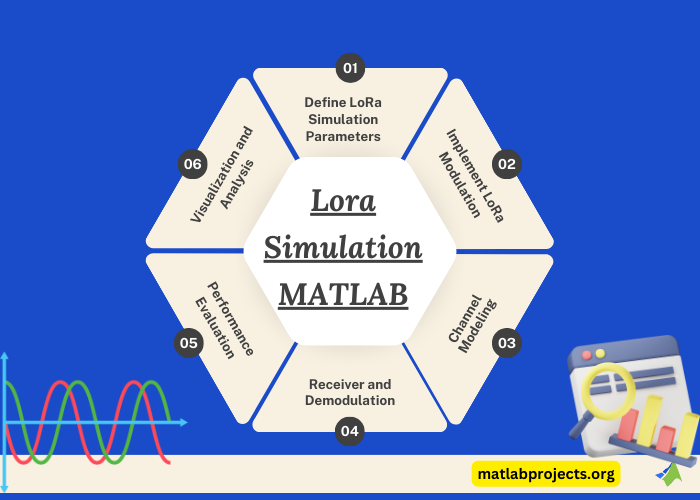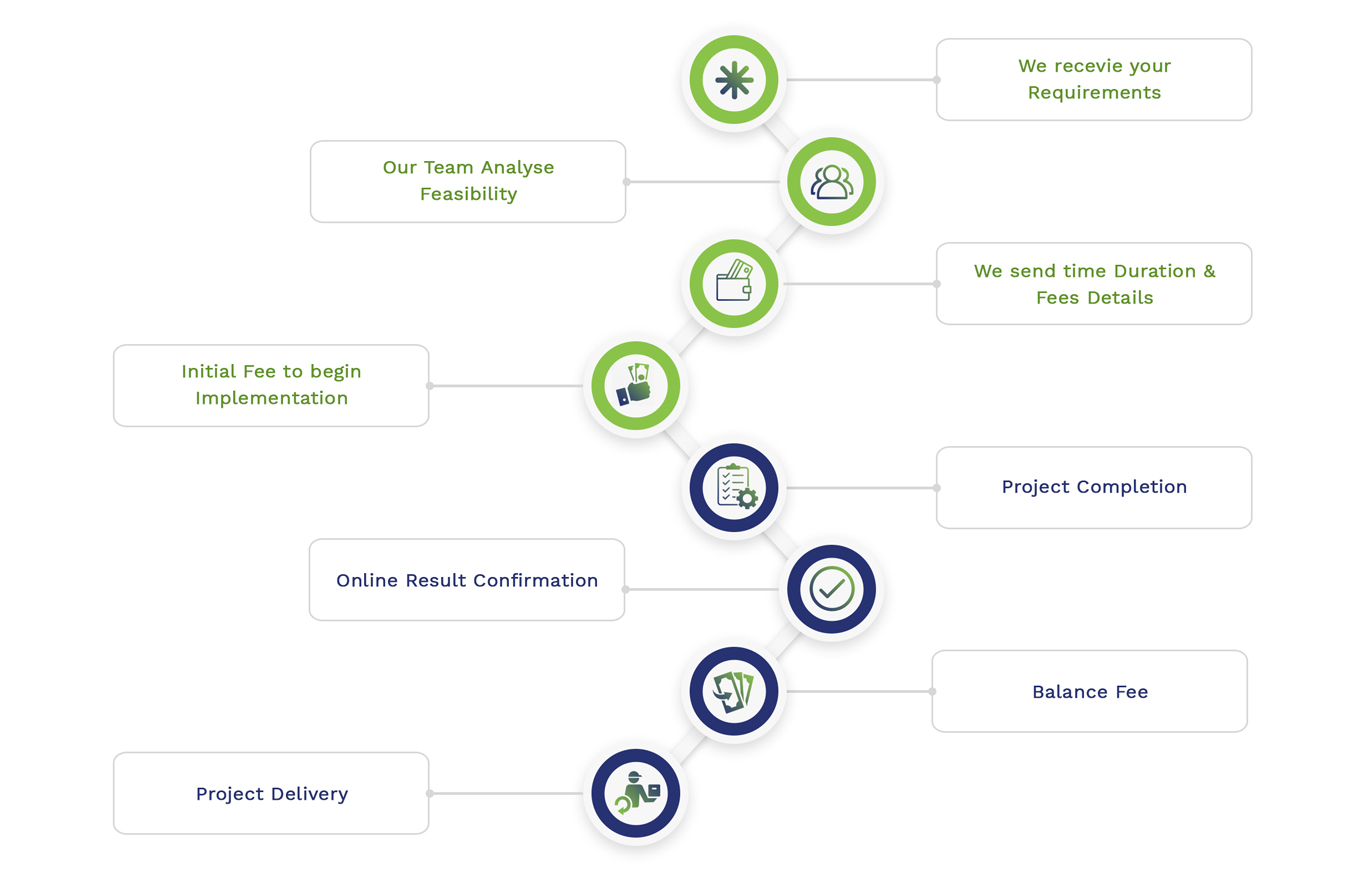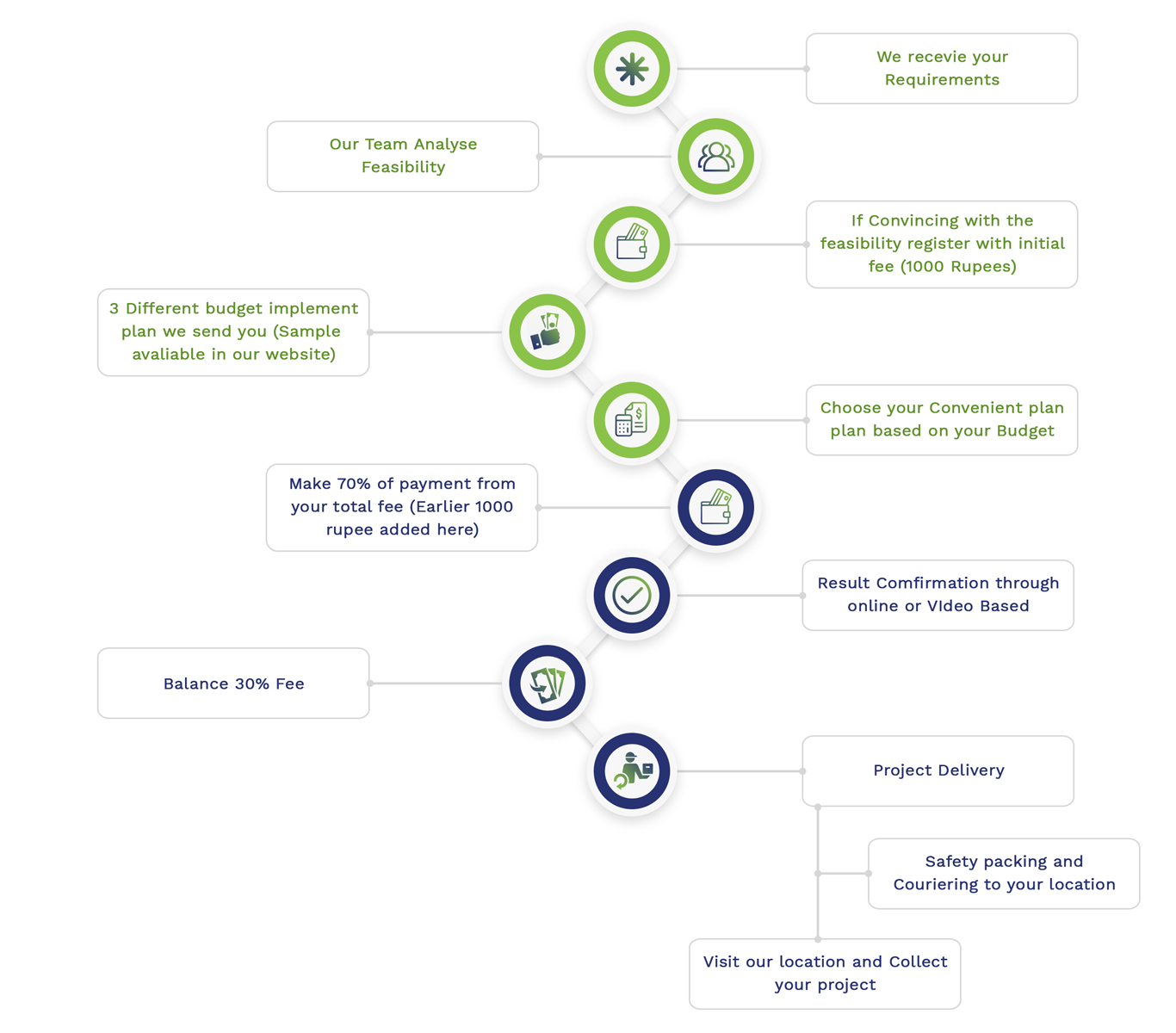Specifically for IoT-based applications, simulation of Long Range (LoRa) technology in MATLAB is very useful to investigate its performance and features and is examined as a better approach. By encompassing various factors such as network protocols, modulation methods, and signal propagation, MATLAB enables for designing and simulation of LoRa networks in an in-depth manner because of having a wider collection of toolboxes. To carry out the process of LoRa simulation in MATLAB, we suggest a general procedure to consider:
Step 1: Specify LoRa Simulation Parameters
Initially, all the major parameters for your LoRa simulation have to be specified. It encompasses:
- Spreading Factor (SF): It typically impacts range and data rate as it ranges from 7 to 12.
- Bandwidth (BW): General values in bandwidth are 125 kHz, 250 kHz, and 500 kHz.
- Coding Rate (CR): It affects the abilities of error correction as it ranges from 4/5 to 4/8.
- Transmission Power and Receiver Sensitivity are also included in the major parameters.
- Channel Model: Channel model involves interference contexts, noise levels, and path loss model.
Step 2: Implement LoRa Modulation
In general, Chirp Spread Spectrum (CSS) is utilized by LoRa. Sometimes, there might be a requirement to apply LoRa modulator if an in-built LoRa modulator might not be identified in MATLAB:
- Generate Chirps: On the basis of the spreading factor, develop downchirps and upchirps.
- Modulate Data: For the transmission purposes, you should map your data bits to the developed chirps.
% Example of generating a simple upchirp
fs = 1e6; % Sampling frequency
T = 1e-3; % Chirp duration
t = 0:1/fs:T-1/fs;
f0 = 0; % Start frequency
f1 = fs/2; % End frequency
upchirp = chirp(t,f0,T,f1,’linear’);
Step 3: Channel Modeling
After the implementation, the transmission medium must be simulated:
- Path Loss: Appropriate to your context, apply a path loss model like highly complicated urban models or free-space path loss models.
- Noise: To simulate channel noise, gaussian noise has to be appended to the signal.
- Interference: From various technologies or other LoRa signals, include interference possibly.
% Example of adding noise to a signal
rxSignal = awgn(upchirp, 30, ‘measured’); % Add white Gaussian noise with 30 dB SNR
Step 4: Receiver and Demodulation
Then, apply the capability of the receiver:
- Signal Detection: The incoming chirps have to be found and integrated to the signal.
- Demodulation: The chirps that are obtained must be demodulated back into bits. The process of connecting the obtained signals with the familiar chip patterns is also included.
Step 5: Performance Assessment
Performance of your LoRa simulation should be assessed appropriately:
- Bit Error Rate (BER): To estimate the BER, contrast the shared and obtained data.
- Packet Delivery Rate: For accessing the success rate, simulate several transmissions.
- Range and Coverage: It is significant to examine in what way the efficient range is impacted by spreading factor and other major parameters.
Step 6: Visualization and Analysis
To examine the simulation outcomes, develop visuals and plots:
- Signal Waveforms: The shared and obtained signals have to be plotted.
- Spectrum: For visualizing the spectrum of LoRa signals, utilize the spectrumAnalyzer in MATLAB.
- Performance Metrics: Contrary to different parameters such as transmission power and spreading factor, plot range, BER, or other major indicators.
figure;
subplot(2,1,1);
plot(t, upchirp);
title(‘Transmitted Signal’);
xlabel(‘Time (s)’);
ylabel(‘Amplitude’);
subplot(2,1,2);
plot(t, rxSignal);
title(‘Received Signal with Noise’);
xlabel(‘Time (s)’);
ylabel(‘Amplitude’);
Does the NS 3 simulator support the LoRa and the Adaptive Data Rate feature in the LoRa?
In low-power, wide-area networks (LPWANs), Long Range (LoRa) technology is utilized in an extensive manner. Several specific aspects in Internet of Things (IoT) advancements and research, including transmission power, data rates, and airtime can be enhanced by its Adaptive Data Rate (ADR) characteristic.
The following are general descriptions on the basis of the aid for LoRa and its ADR characteristics in NS-3:
- LoRa Support: To simulate LoRaWAN networks that are commonly related to LoRa mechanism, the modules and dedications which are created by the research committee have been assisted by NS-3. For assessing the LoRaWAN efficiency in different contexts like diverse energy configurations, channel tactics, and spreading factors, these dedications intend to offer tools. By focusing on various factors such as scalability, interruption, and range, the simulator enables researchers, specifically for designing the LoRa networks activity.
- Adaptive Data Rate (ADR): With the intention of extending the network ability and battery durability, ADR is modeled for the enhancement of transmission power of devices and data rate in terms of network states. It is generally considered as a major aspect of LoRaWAN. On the basis of network states like connection standard and signal-to-noise ratio (SNR), the simulation of dynamic adaptation of these arguments would be included in the assistance for ADR in respect to NS-3. In adapting the data rate and energy levels of LoRa devices, the decision-making procedure of the network server must be designed by the executions in NS-3 in a precise manner.

LORA SIMULATION PROJECTS
Explore exciting research opportunities with our innovative LORA SIMULATION PROJECTS! We offer unique LORA SIMULATION PROJECTS topic that will fill a crucial research gap and set the right direction for your study. Reach out to us for expert guidance on developing your research ideas.
- LoRaute: Routing Messages in Backhaul LoRa Networks for Underserved Regions
- On Transmission Time of a LoRa Packet in a LoRa-Based IoT System for Underground Environment
- Improved Visibility of LoRa Networks Using LoRa Performance Evaluation Tool
- Exploring Vehicle Tracking Performance with LoRa Technology: An Analysis of Speed and Environmental Factors
- Researching on Signal Transmission Performance of LoRa Technology in Urban Environment
- Experimental Results of LoRa Network Radio Propagation Modeling in Campus Area
- Distributed Air-Time Reduction In Multi-Hop LoRa Networks With Multiple Spreading Factors
- Analysis of LoRa (Long Range) Performance as The Development of Remote Communication for Earthquake Detection Systems in High-rise Buildings
- Hazardous Area Monitoring System in Industries Using Lora Module
- Initial Coverage Analysis of LoRa Communication for Light Buoy Monitoring System in Port Area
- A Novel Approach to Collision Avoidance in LoRa Networks
- LoRa Preamble Detection Robust to Inter-channel Interference
- Sprinkler Irrigation System for Pakcoy Cultivation Based on Mamdani Fuzzy Logic and LoRa Communication
- Dynamic Slot Allocation Protocol for Multi-Channel LoRa Communication
- Joint Channel Estimation and Signal Detection for LoRa Systems Using Convolutional Neural Network
- Signal Denoising and Detection for Uplink in LoRa Networks Based on Bayesian-Optimized Deep Neural Networks
- A Field Test for Maximizing Coverage through Multi-Hop D2D LoRa Transmission
- Multi-Hop LoRa Communication for Natural Disaster Management: A Field Test
- Balancing reliability and energy efficiency in LoRa networks using reinforcement learning
- Combining Beat-frequency and correlation detection method for ranging in LoRa system
Subscribe Our Youtube Channel
You can Watch all Subjects Matlab & Simulink latest Innovative Project Results
Our services
We want to support Uncompromise Matlab service for all your Requirements Our Reseachers and Technical team keep update the technology for all subjects ,We assure We Meet out Your Needs.
Our Services
- Matlab Research Paper Help
- Matlab assignment help
- Matlab Project Help
- Matlab Homework Help
- Simulink assignment help
- Simulink Project Help
- Simulink Homework Help
- Matlab Research Paper Help
- NS3 Research Paper Help
- Omnet++ Research Paper Help
Our Benefits
- Customised Matlab Assignments
- Global Assignment Knowledge
- Best Assignment Writers
- Certified Matlab Trainers
- Experienced Matlab Developers
- Over 400k+ Satisfied Students
- Ontime support
- Best Price Guarantee
- Plagiarism Free Work
- Correct Citations
Expert Matlab services just 1-click

Delivery Materials
Unlimited support we offer you
For better understanding purpose we provide following Materials for all Kind of Research & Assignment & Homework service.
 Programs
Programs Designs
Designs Simulations
Simulations Results
Results Graphs
Graphs Result snapshot
Result snapshot Video Tutorial
Video Tutorial Instructions Profile
Instructions Profile  Sofware Install Guide
Sofware Install Guide Execution Guidance
Execution Guidance  Explanations
Explanations Implement Plan
Implement Plan
Matlab Projects
Matlab projects innovators has laid our steps in all dimension related to math works.Our concern support matlab projects for more than 10 years.Many Research scholars are benefited by our matlab projects service.We are trusted institution who supplies matlab projects for many universities and colleges.
Reasons to choose Matlab Projects .org???
Our Service are widely utilized by Research centers.More than 5000+ Projects & Thesis has been provided by us to Students & Research Scholars. All current mathworks software versions are being updated by us.
Our concern has provided the required solution for all the above mention technical problems required by clients with best Customer Support.
- Novel Idea
- Ontime Delivery
- Best Prices
- Unique Work
Simulation Projects Workflow

Embedded Projects Workflow



 Matlab
Matlab Simulink
Simulink NS3
NS3 OMNET++
OMNET++ COOJA
COOJA CONTIKI OS
CONTIKI OS NS2
NS2






